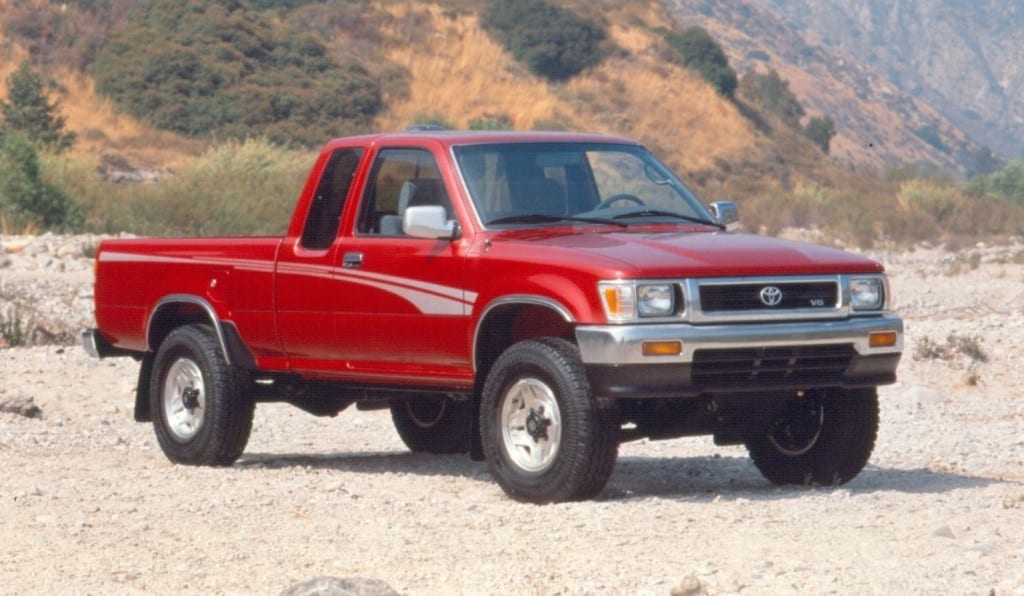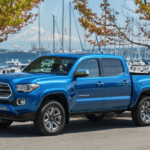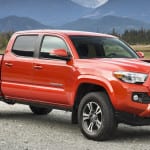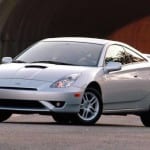The Toyota Tacoma has evolved along with its size since it was first introduced in 1995. Not only has the Tacoma gone from a compact pickup to a mid-size pickup, but it has also become more powerful and more sophisticated over the years. What you’ll find at a Toyota dealer is a stylish and powerful truck that has gone through two decades of improvements and refinement — and you’ll find it at a great price!
Understanding the Tacoma’s history helps you understand the quality workmanship and design that the current model represents. Here’s a brief look back at the history of the Toyota Tacoma:
First Generation
The Toyota Tacoma was first introduced a couple of months into 1995 as a replacement for the Toyota Hilux, which was also known simply as Toyota Pickup. The Hilux was discontinued in the United States, but it still continues to be produced for international marketplaces, including South America and Thailand. The Hilux had been produced in America since 1968 before being discontinued.
The Tacoma was intended to improve the ride quality that the Hilux offered, as well as to improve handling, comfort and safety. Meanwhile, the Hilux was designed to be a rugged and powerful ride, though not necessarily a comfortable one. The size and the features of the new Tacoma were targeted to drivers who would use their pickup trucks as personal vehicles, as well, instead of for commercial or industrial use.
The Tacoma was introduced after five years of development, and it came as either a two-wheel drive or four-wheel drive truck and offered three engine options. The base model came with a 2.4-liter four-cylinder that put out 142 horse power and 160 pounds per feet of torque. Upgrades included a 2.7-liter four-cylinder that put out 150 horse power and 177 pounds per feet of torque and a 3.4-liter V6 that put out 190 horse power and 220 pounds per feet of torque. The base model was fuel efficient for a pickup, offering 29 mpg on the highway.
The base model and V6 engine were both offered in two-wheel drive, and they both included automatic or manual transmission options. These options changed over the years, with options such as crew cabs and new suspension.
The Tacoma was a success right out of the gate, and younger buyers formed its core market. Over the next 10 years, the first generation underwent a number of changes to both the design and the mechanics.
In 1997, a prerunner version was introduced that shared the same styling, engine options and suspension of the 4×4 models introduced that year. The Prerunner Tacoma came with an optional off-roading package for those who still wanted the power and durability of the previous Toyota pickup models, as well as the comfort and ride quality that the Tacoma offered.
The Tacoma underwent minor face lifts in 1996 and 1997, including changes to the grille, tailgate badging, head lights, and engines. Under the hood, the Tacoma got new rear leaf springs and a coil-on-plug ignition. A passenger side air bag was also added.
In 2000, the Tacoma got another face lift and offered an S-Runner trim package that came with a 3.4-liter V6 engine, a five-speed manual transmission, 16-inch alloy wheels, and gas shocks. Only a couple hundred of the package were sold over the next four years, so this model has become a bit of a collector’s item thanks to its rarity.
A crew cab was also introduced in 2000. The crew cab had four doors, but the extended cab came with only two doors. The extended cab had a longer bed than the crew cab, 6 foot compared to 5-foot-5-inches.
The Tacoma continued to gain in sales over the years during its first generation. By 2004, it was outselling the Dodge Dakota and the Nissan Frontier. In 2005, it was named Truck of the Year by Motor Trend Magazine.
Second Generation
The second generation of the Toyota Tacoma was introduced in 1995, and it ran through the current model year. The 2016 model will introduce the third generation.
The new generation of the Tacoma grew to a mid-size pickup, and it included a plethora of options, including two engines, four transmissions, three cabs (regular, access cab and double cab), and two bed lengths (6 foot or 5 foot), for a total of 18 configurations.
The two engine choices were a 2.7-liter 2TR-FE four-cylinder that put out 159 horse power and 180 pounds per feet of torque and a 4.0-liter 1GR-FE V6 engine that put out 236 horse power and 266 pounds per feet of torque. The transmission options were a four-speed automatic, five-speed automatic, five-speed manual, and six-speed manual.
An X-runner trim level was also introduced with the second generation. It included the 4.0-liter engine with the six-speed manual transmission, an upgraded suspension package, and 18-inch alloy wheels. Other features included down-hill assist control, hill-start assist control, optional rear-locking differential, and an optional off-roading package.
The new Tacoma also featured bed upgrades, such as a deck rail system, tie down cleats, hook pins, and storage boxes. The off-road package also included a power outlet in the bed.
Many more features were added over the following years. Some of the optional features on the 2005 model were made standard the following year, and additional interior colors were added the year after that. Extra safety features were added in 2009, and the Tacoma received a face lift that year. Some of the design changes included a revised grille, new LED tail lights, and smoked head lights. The model also came with four new exterior colors and some new interior features.
Another refresh came in 2012, when the Tacoma got a new grille, head lights, front bumper, hood, and shark fin antenna. The interior was also revamped, and some features were added, such as satellite radio.
A touch-screen audio system was introduced in 2013, and an SR trim was added in 2014. The 2015 models were introduced without a regular cab, which beefed up the Tacoma’s profile even more.
Numerous safety features were added to the Tacoma throughout the second generation. A rollover sensor was added in 2008 to deploy side curtain airbags during a rollover. The Star Safety System was introduced in 2009, and some features included traction and stability control. Side torso air bags for the front row and side curtain air bags for both rows also became standard.
Third Generation
Toyota is currently working on developing the 2016 Tacoma, which will introduce the third generation of the truck.
The 2016 Toyota Tacoma was previewed at the 2015 Detroit Auto Show in January. It features an updated exterior look, with a larger grille, more powerful head lights, an air dam, an infused spoiler, and a redesigned bed. The new Tacoma will have a 2.7-liter Inline4 engine and a six-speed automatic or five-speed manual in the base model. An upgraded 3.5-liter V6 engine will also be available with a six-speed manual or automatic transmission. The body of the truck will feature high-strength steel for better performance and a lower weight, which should improve fuel efficiency. The suspension has also been upgraded for better off-road performance.
Five trim levels will be available on the 2016 Toyota Tacoma. Only the Access Cab and Double Cab will be offered.
Interior upgrades include soft-touch materials instead of plastic, a bigger touch screen display, a new instrument panel, and better insulating to improve ride quality. Dual-climate control will also be introduced for the first time. A terrain-select mode will also be introduced for the first time in the TRD trim.
The 2016 Toyota Tacoma should be available in a couple of months at your local NH Toyota dealer. Visit Irwin Toyota today to test drive the current model Tacoma or to learn more about the 2016 model as information becomes available.






